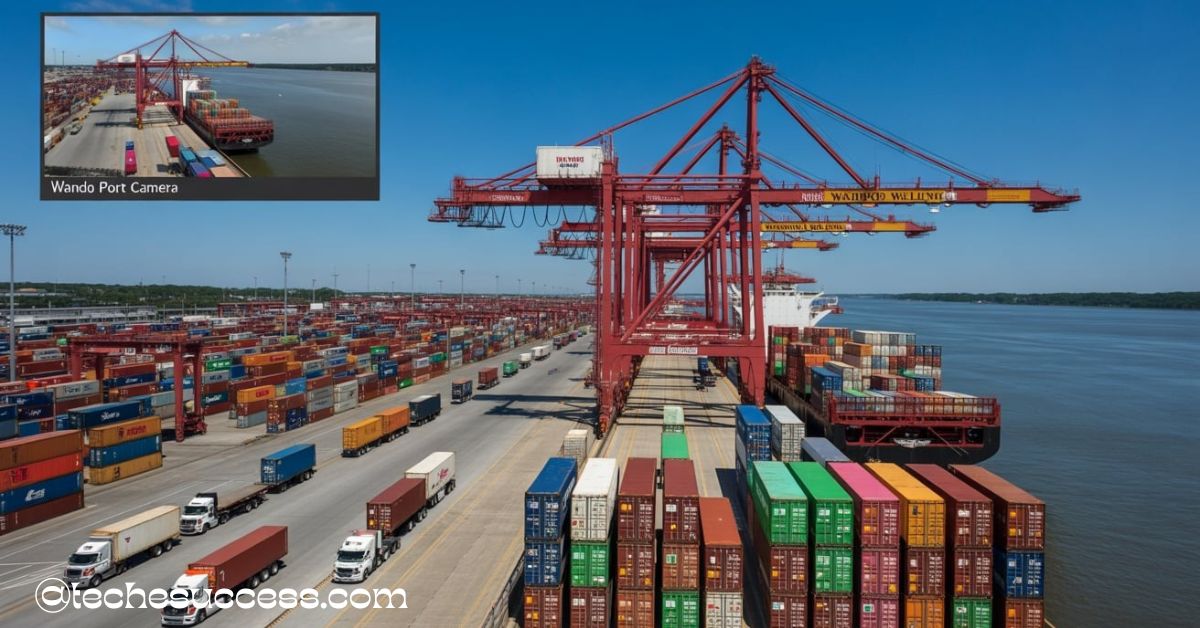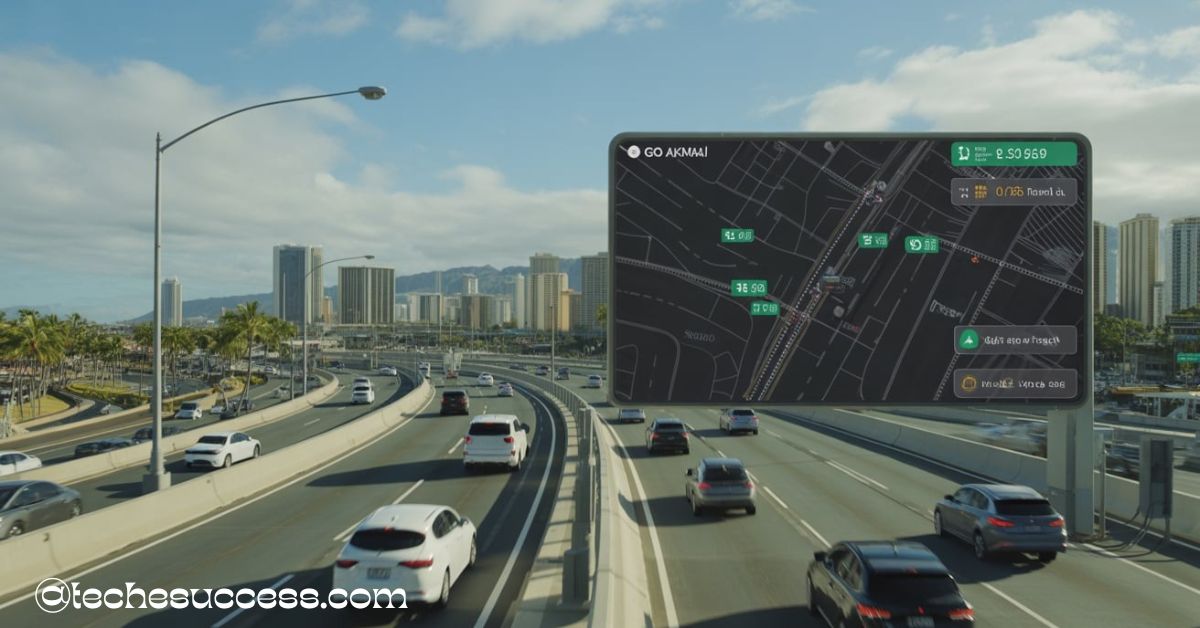The wando port camera offers a real-time view of inbound traffic and gate activity at Wando Welch Terminal in North Charleston. It helps truckers, shippers, and port staff monitor container flow and reduce delays. Easily accessible online, it enhances port visibility and operational planning.
“Stay tuned with us as we dive deeper into everything you need to know about the [wando port camera] — from how it works to why it’s a vital tool for port operations and logistics efficiency.”
What Is the Wando Port Camera?
The Wando Port Camera is a real-time monitoring tool positioned at the Wando Welch Terminal, one of the busiest shipping terminals in South Carolina. Operated by the South Carolina Ports Authority (SC Ports), this camera system provides live visual access to the inbound traffic lanes, allowing users to see the flow of container trucks entering the port. With just a few clicks, logistics companies, truck drivers, and shipping managers can monitor activity at the terminal, plan operations more efficiently, and reduce delays.
As global trade continues to expand, port visibility becomes increasingly important. The Wando Port Camera plays a vital role in offering transparency and real-time updates that help streamline the supply chain. Unlike traditional methods of traffic reporting, which can be delayed or rely on second-hand information, the live feed ensures that decisions are based on current conditions. Whether you are a fleet manager or an independent driver, having access to Wando port cameras can provide significant operational advantages.
The Wando Port Camera is not just a technical installation—it represents a shift toward smart port infrastructure, where real-time data and visual monitoring support faster, more informed decisions. It’s a modern solution to a long-standing logistical challenge.
Overview of Wando Welch Terminal
The Wando Welch Terminal (WWT) is the flagship terminal of the Port of Charleston, operated by SC Ports. Strategically located in Mount Pleasant, South Carolina, it handles a majority of the container traffic moving through the state. WWT boasts a large container yard, advanced crane systems, and recently upgraded wharf infrastructure to accommodate larger vessels.
Spanning over 400 acres, WWT is designed to handle mega-ships that require deep berths and wide turning basins. The terminal is equipped with Neo-Panamax cranes capable of reaching across vessels up to 22 containers wide. These capabilities make it one of the most efficient and high-capacity terminals on the U.S. East Coast.
Its importance in the supply chain cannot be overstated. The terminal connects to major interstate highways and rail networks, enabling quick transportation to distribution centers across the Southeast. Thousands of trucks move through WWT daily, making efficient traffic control essential. That’s where Wando port cameras become especially valuable. By monitoring real-time conditions, terminal managers can coordinate gate operations and manage congestion more effectively.
The Wando Welch Terminal’s continuous investment in smart technology, such as the Wando Port Camera, underscores its role as a forward-thinking logistics hub.
How the Wando Port Camera Works
The Wando Port Camera is mounted at key vantage points throughout the terminal’s inbound lanes. It captures live imagery of truck traffic approaching the gates, typically updating every 30 seconds. These static images are then streamed to the SC Ports website, where users can view the latest snapshot without needing any special software.
This system relies on a stable internet connection and high-definition imaging to ensure that each frame provides a clear, accurate depiction of terminal activity. The camera’s fixed position allows viewers to assess congestion levels, see vehicle positioning, and estimate wait times with reasonable accuracy.
From a technical standpoint, the camera is integrated into SC Ports’ broader digital infrastructure. It works in tandem with gate control systems and terminal operating software to maintain efficiency and coordination. In the future, these cameras may be enhanced with AI capabilities, such as vehicle recognition or automated queue analysis, but for now, their main function is to provide consistent visual data.
By accessing the camera, stakeholders can make immediate decisions, such as rerouting trucks or rescheduling pickups. It reduces guesswork and promotes more agile, data-informed logistics.
Where to Access the Wando Port Camera Feed
Accessing the Wando Port Camera feed is straightforward. SC Ports hosts a dedicated page for terminal cameras, where users can find up-to-date images for several facilities, including Wando Welch Terminal. Here’s how to access it:
- Visit the official SC Ports website (scspa.com).
- Navigate to “Facilities” and select “Wando Welch Terminal.”
- Look for a section labeled “Inbound Lanes Camera.”
- Click to view the most recent image, which refreshes every 30 seconds.
There’s no login required, and the feed is publicly accessible, ensuring transparency and usability for all port users. The camera feed is particularly popular among truck drivers and dispatchers, who use it to monitor traffic before leaving for the terminal. This helps avoid long waits and improves scheduling.
Mobile users can also access the camera through SC Ports’ responsive site or through a Wando port camera app, allowing real-time checks on the go. Though the feed is not a continuous video stream, its frequent refresh rate makes it an effective tool for live monitoring. For easier navigation, a Wando port camera map might also be integrated in the future to show camera positions across terminal zones.
Benefits of Using the Wando Port Camera
The Wando Port Camera offers a variety of benefits that enhance efficiency and transparency for everyone involved in port logistics. One of the primary advantages is real-time visibility. Whether you’re a truck driver planning your route or a logistics manager coordinating cargo pickups, the ability to see current traffic conditions helps you avoid delays and optimize scheduling.
Operationally, the camera supports smoother gate operations by giving terminal staff a visual reference for adjusting traffic flow. During peak periods or unexpected slowdowns, port authorities can use the feed to reallocate staff or redirect vehicles. It’s a proactive approach that reduces bottlenecks.
From a business perspective, the Wando Port Camera today minimizes the risk of demurrage fees and delivery penalties caused by missed appointments. Trucking companies gain a competitive edge by staying informed and adjusting routes in real time.
Moreover, the camera enhances safety by helping users understand congestion points and plan accordingly. With a clearer picture of inbound conditions, drivers can enter the terminal more safely and confidently.
Finally, the transparency offered by the camera fosters trust among stakeholders—importers, exporters, carriers, and terminal operators all benefit from shared access to live, reliable information.
Technology Behind the Wando Port Camera
Behind the scenes, the Wando Port Camera is powered by robust technology designed for continuous performance in a demanding environment. The camera system typically includes weather-resistant enclosures, high-definition optics, and secure data transmission protocols to ensure uninterrupted service.
Each camera is strategically mounted to capture wide-angle views of inbound truck lanes. The resolution is optimized for clarity while minimizing data bandwidth, striking a balance between image quality and performance. The camera feed is hosted on SC Ports’ secure servers and integrated into their web infrastructure for public access.
Additionally, the camera system may include infrared capabilities for low-light conditions, ensuring functionality during early morning or late-night operations. The periodic refresh interval—currently every 30 seconds—is managed by server-side scripting that pushes the latest image to the web interface.
Power redundancy, such as battery backups or solar panels, may be installed to maintain camera uptime during grid failures. Cybersecurity measures, including firewalls and SSL encryption, help safeguard the data.
As part of a broader movement toward smart port infrastructure, the Wando Port Camera represents a stepping stone toward greater automation and digital integration in the maritime logistics industry.
Recent Port Upgrades Impacting Camera Use
Several infrastructure upgrades at the Wando Welch Terminal have enhanced the functionality and importance of the Wando Port Camera. One major development is the recent completion of the wharf toe wall project, which has strengthened berth stability and allowed the terminal to handle larger vessels.
Deeper berths, now reaching 52 feet, accommodate Neo-Panamax ships, significantly increasing container throughput. These changes have resulted in heavier traffic volumes and higher truck flow rates, making the camera feed more valuable than ever. Real-time visibility is now crucial for managing the terminal’s increased load.
Additionally, new cranes and automation tools have been introduced to streamline container handling. This means quicker turnaround times for trucks and higher expectations for just-in-time logistics. The camera feed helps meet those expectations by offering a visual reference for planning pick-ups and deliveries.
Road infrastructure around the terminal has also seen improvements, including expanded entry lanes and signage upgrades. These changes, while beneficial, require users to stay informed—and the Wando Port Camera offers a real-time look at how those changes are impacting access and flow. Users tracking cargo movements also benefit from tools like Wando Welch terminal tracking.
Real-Time Use Cases of the Wando Port Camera
In practice, the Wando Port Camera supports a wide range of real-time logistics scenarios. For example, a trucking company may check the feed before dispatching drivers to avoid peak congestion periods. This minimizes wait times and fuel usage, saving money and time.
Another real-world use case involves port authorities using the camera during vessel unloading. When a high-volume container ship arrives, the camera feed helps monitor gate flow, allowing real-time adjustments in labor and equipment deployment.
Dispatchers benefit by coordinating multi-stop routes more effectively. If one terminal shows light traffic, they may prioritize pickups there before heading to a busier site. The camera feed thus becomes a decision-making tool in complex scheduling environments.
During weather disruptions or port closures, the Wando Port Camera provides immediate insight into whether operations have resumed. This level of transparency can significantly reduce uncertainty and miscommunication.
In times of construction or maintenance, stakeholders rely on the feed to navigate detours or temporary lane shifts. Overall, the camera plays a key role in day-to-day operations and long-term strategic planning. Users also refer to the Wando Welch Terminal vessel schedule to align their activities with ship arrivals.
How Truckers and Shippers Use the Wando Port Camera
For truck drivers and shippers, the Wando Port Camera is a practical tool that can be used daily. Before leaving the depot, a driver can check the camera to see if traffic at the Wando Welch Terminal is moving smoothly. If there’s a backlog, the trip can be postponed, or an alternate route can be selected.
Dispatchers often view the camera multiple times a day, coordinating the timing of container pickups with what they see on the feed. This minimizes unnecessary waiting and helps maintain appointment schedules. For shippers, this level of planning translates into fewer delays and more predictable delivery times.
Third-party logistics companies use the camera as part of their terminal visibility dashboards, integrating real-time camera feeds into transport management systems. This automation further reduces manual checking and improves operational response.
Independent drivers, especially those unfamiliar with Charleston’s port system, find the camera feed to be a confidence booster. It eliminates surprises and supports smoother gate entries. Whether you’re operating a single truck or managing a fleet, using the Wando Port Camera is a smart way to stay informed and efficient.
Checking Wando Welch Terminal container availability before scheduling pick-ups is another way drivers benefit from port technology.
Limitations of the Wando Port Camera Feed
While the Wando Port Camera is a valuable resource, it does have some limitations. The feed consists of still images refreshed every 30 seconds, not continuous video. This can create minor delays in visibility, especially during fast-changing traffic conditions.
Another limitation is the fixed field of view. The camera captures a wide area but may miss activity happening outside its angle. Users should be cautious when drawing conclusions from what they see, especially if making time-sensitive decisions.
Weather can also impact image clarity. Heavy rain, fog, or low light can obscure visibility, though most cameras are equipped with technology to mitigate these effects. Additionally, the feed depends on stable internet and power. Outages can temporarily suspend access.
There’s also no interactive component—users cannot zoom, pan, or tilt the camera. While sufficient for general monitoring, this restricts detailed inspections or analysis.
Finally, users should be aware that the camera is primarily designed for logistics support, not security. It should not be relied upon for incident tracking or law enforcement purposes. Users looking for broader visibility might also consult North Charleston Port Cameras for updates on nearby terminals.
Future Enhancements for Wando Port Camera Technology
Looking ahead, there are several potential enhancements for the Wando Port Camera that could make it even more effective. One possibility is upgrading from static images to live video streaming. This would provide smoother, real-time visibility and improve response times.
Another innovation could be AI-powered analytics. By integrating license plate recognition or container tracking, the system could automatically identify delays, bottlenecks, or unusual traffic patterns. Alerts could then be sent to drivers or dispatchers in real time.
Mobile app integration is another promising area. If SC Ports develops an official Wando Port Camera app with embedded camera feeds and push notifications, users could receive traffic updates while en route.
Cloud-based storage could also enhance functionality by allowing users to review historical footage or analyze trends over time. This could be helpful for logistics audits or performance reviews.
Lastly, expanding the number of camera viewpoints around the terminal would offer broader coverage and better situational awareness. All these improvements would contribute to a smarter, more connected port ecosystem.
Conclusion: Why the Wando Port Camera Is Essential for Port Efficiency
In an era of fast-paced global trade, the Wando Port Camera stands out as a simple yet powerful tool for improving supply chain visibility. Positioned at the heart of the Wando Welch Terminal, it provides real-time insights into inbound traffic, helping drivers, shippers, and terminal managers make better, faster decisions.
From supporting just-in-time logistics to enhancing safety and transparency, this camera system plays a critical role in modern port operations. As the Port of Charleston continues to grow and evolve, tools like the Wando Port Camera will be key to maintaining efficiency and competitive advantage. Knowing the Wando Port hours can further streamline planning for all users.
FAQs
1. What is the update interval of the Wando Port Camera?
The Wando Port Camera refreshes every 30 seconds, offering near real-time visibility of terminal traffic.
2. Can I access the Wando Port Camera on my phone?
Yes, the camera feed is accessible via SC Ports’ mobile-responsive website or the upcoming Wando Port Camera app, allowing users to check traffic on the go.
3. Is the Wando Port Camera free to use?
Yes, it is publicly available without any registration or subscription requirement.
4. Does the Wando Port Camera provide video?
Currently, it offers still images only. A live video stream may be considered in future upgrades.
5. How does the Wando Port Camera help logistics companies?
It improves planning, reduces delays, and enhances operational efficiency by providing real-time traffic visibility.
Also Read:













Leave a Reply